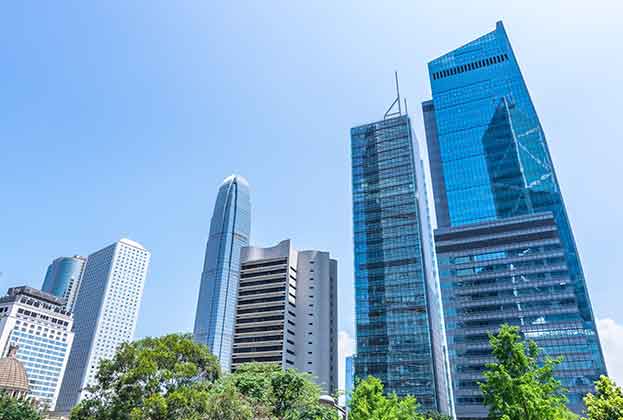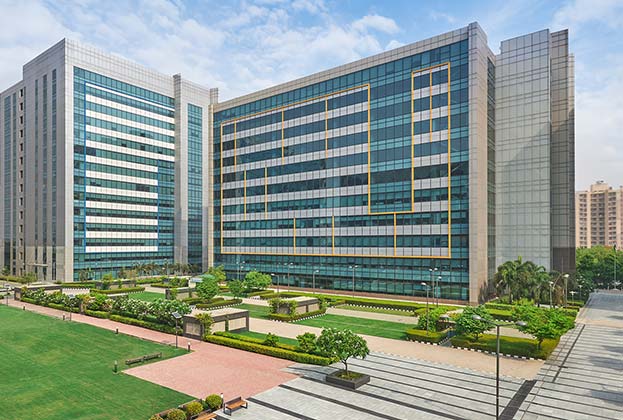More certainty around interest rates and borrowing costs should help to facilitate a floor in pricing for offices, and eventually a recovery in investment activity, particularly for those investors who can separate the art from the artist
Europe, Middle East, and Africa (EMEA)
Summer is traditionally a quiet period for real estate investors in Europe. In any given year, investment volumes are typically 10-15% lower in Q3. But even by these standards, the current stagnation is unusual (a common theme across most sectors and geographies). The US$10.1 billion of office investment recorded in Europe this quarter represents a 14-year low going back to the GFC. Currency fluctuations make this comparison appear worse than it is, but when looking at the number of individual property transactions, Q3 activity was 8% down on 2009.
Overall office investment volumes in Europe fell by 62% y/y in Q3, bringing the full year-to-date figures down by 60%. The country breakdown is somewhat mixed. Germany and Italy are notable laggards, both seeing greater falls than the regional average. France year-to-date investment has held up relatively well (-43% y/y), albeit that Q3 was 64% down on the same period last year. Spain meanwhile has continued to show some resilience – total volumes are down by around 50% y/y both in terms of Q3 and year-to-date comparisons – flattered somewhat by a lower base in 2022, but also supported by strong inflows of private capital.
Cross border investment has fallen by a similar scale to the total market. Sentiment in the US is clearly impacting appetite for European offices; inflows of capital from US and Canadian investors are down by a combined 81% year-to-date, underpinning a near 78% decline in inflows from outside Europe. But despite this, the US remains the primary source of capital originating outside of Europe. Elsewhere, Japanese and Singaporean investors are the most active from Asia Pacific, with the South Koreans notable only by their absence.
By contrast, intra-European flows of cross border capital are holding up relatively better. German and French investors in particular are supporting this trend – possibly as a means to diversify away from struggling domestic markets, but also due to the higher yields available elsewhere. French outbound investment is linked to the local SCPI funds, which have remained active this year when others have retrenched (particularly in the first six months).
Summer is traditionally a quiet period for real estate investors in Europe … But even by these standards, the current stagnation is unusual
Oliver Salmon, Global Capital Markets, World Research
Major institutions are marginal net sellers of offices so far this year. This trend is likely to continue in the short term, with the large open-ended funds in Germany and France expected to bring more stock to market as they face pressure from growing client redemption requests. This may provide a catalyst for greater liquidity, but the question remains whether there will be much competition on the buy side, particularly for larger assets.
In part, this is driven by pricing expectations. Yields have continued to push outwards this quarter, but ongoing discrepancies between buyer and seller expectations would suggest they have further to go in some markets. And even if they do rebase further, according to our latest regional sentiment survey, investors are scaling back interest in CBD offices, with the proportion of respondents looking to deploy into offices over the next 12 months falling from 52% in 2022 to 29% 2023.1
A further constraint to deal activity in mainland Europe is a perceived yield arbitrage favouring UK offices. This is feeding into a more encouraging outlook in the UK, as we look ahead to what is traditionally the busiest period of the year. September was the most active month for London City office transaction since March, and some larger deals have successfully completed in recent months. Asia Pacific capital remains steadfastly committed to London, accounting for around 60% of volumes this year. In particular, Asia Pacific investors are the most prevalent buyer group when it comes to larger lot sizes.
A lack of available stock is a big factor in the lower transactional volumes and vendors should be encouraged by an apparent narrowing in buyer and seller price expectations – which in combination with interest rate stability and a positive outlook for rental growth, should presage a stabilisation in yields.

North America
US investment volumes fell by nearly 63% y/y in Q3, leaving them down by 62% year-to-date. The decline in activity is underpinned by the withdrawal of major institutions from the market as they recalibrate their portfolios into other sectors. This represents an acceleration of a longer-term trend; Blackstone, for example, has reduced their exposure to US offices from around 60% in 2007 to just 2% today. Overall, institutional investment volumes are down by 78% year-to-date and 86% in comparison with the same period in 2019 and now account for just 11% of total office investment in the US, down from over 40% a decade ago.
Cross border volumes are also a fraction of the recent past. The strong dollar and high interest rate environment make it difficult for non-USD-denominated investors to find value in the US, even before you consider the added uncertainty around the outlook for offices in comparison with other regions.
The absence of institutional and cross border money is impacting the average deal size, with around 54% of deals backed by private money this year. The number of individual property transactions valued at greater than US$100 million is down by 75% year-to-date, while there is virtually no activity for deals above US$500 million. This does mean however that there remains an active pool of buyers for smaller lot sizes, and this is bringing some life to suburban office markets, which also benefit from a more straightforward redevelopment proposition on lease expiry.
Yields are unchanged this quarter, but the expectation remains that the correction has further to run. This sentiment is reflected in public markets; at end-October, the median discount to NAV for US office sector REITs was around 46%, compared to an all-property average of 28%, according to S&P Global. Meanwhile, debt costs have continued to rise in line with higher interest rates, with bond yields pushing ever higher as markets acquiesce to ‘higher for longer.’
Excess supply remains a significant constraint. But the market is responding, and there are a number of cities where inventory is falling as older offices are repurposed
Oliver Salmon, Global Capital Markets, World Research
On the occupier outlook, fundamentals remain challenged. The return to office is resisting the shift in corporate mandates, and utilisation rates continue to lag behind the rest of the world. Leasing activity is primarily ‘expiration driven,’ with overall take-up down on the year. Rents are ‘sticky’, with class A properties continuing to see some growth, even in places like Los Angeles where the availability rate is 26.5% (albeit with record-level concessions). As such, discretionary leasing deals may just be waiting for a more significant rental repricing. Some markets, such as New York, are now seeing a decline in office-based employment, which will only reinforce the slowdown.
Excess supply remains a significant constraint. But the market is responding, and there are a number of cities where inventory is falling as older offices are repurposed. In New York, office inventory is down by 2.1 million sqft over the last 12 months. This trend will continue to snowball through a combination of stick (falling values, rising obsolescence, and distressed assets) and carrot (state and local government incentives).
Asia Pacific
Asia Pacific has proven relatively resilient in comparison with other regions, with Q3 investment falling by 52% y/y, bringing year-to-date volumes down by 50%. Asia Pacific remains the only region where institutional investors remain net buyers of offices. Cross border investors also remain active, particularly those also domiciled in the region, with intra-Asia Pacific capital accounting for nearly 80% of total cross border investment this year, up from a near 50:50 split in the same period last year.
The major Canadian investors have virtually withdrawn from regional office markets this year, while US funds are showing a more circumspect 68% decline year-to-date, mainly driven by a slowdown in capital deployed into Japan. By contrast, Singapore (led by the sovereign wealth fund GIC) and Hong Kong investors continue to favour office markets in the region; eight of the largest ten cross border buyers over the last twelve months are headquartered in either Singapore or Hong Kong.
Australia and Singapore have experienced the steepest decline in activity this year (of the core markets), with investment volumes falling by 71% and 51% respectively, year-to-date. In the former, the sharp slowdown is underpinned by a mixture of high interest rates and a slow adjustment in valuations. Yields have risen by a mere 90 bps since the beginning of 2022, compared with a greater than 400 bps rise in the cost of debt. The Australian market often looks to Europe for a comparator, which has seen yields move by 150 bps or more in response to a comparably moderate rise in debt costs. There is little wrong with the occupational market; demand for prime CBD buildings remains robust, supported by resilient economic growth and a flight to quality, and face rents continue to grow as a consequence.
Asia Pacific remains the only region where institutional investors remain net buyers of offices
Oliver Salmon, Global Capital Markets, World Research
In Tokyo, the market is more active, with office investment down by less than 33% year-to-date. The occupational outlook equally looks set to remain largely stable, with some marginal quarterly rental growth expected given falling vacancy. Bifurcation based on office age and location is a narrative shared with most global markets, and while a large pipeline of new supply may upset the current balance, a majority of new major developments have been absorbed with minimal issues so far.
The high cost of borrowing remains a significant constraint in Hong Kong, with three-month HIBOR stabilising above 5% this quarter. End-users are supporting some liquidity in the strata office market, but there are very few en-bloc transactions, with Mainland Chinese capital notable in its absence. More sales are likely to come to market in the coming months, primarily those owned by troubled Mainland developers, but it remains to be seen who will buy them, especially given rents continue to fall amid elevated vacancy.
In South Korea, investment volumes were down by just 33% y/y in Q3. But despite the growing number of sellers eager to introduce new deals to the market, there is a limited pool of institutions with readily available capital. Domestic buyers are more active, possibly following their near-total withdrawal from international markets. But the cost of debt continues to move against would-be investors. The prime yield in Seoul has moved out by around 100 bps so far during this cycle, but we continue to expect a further outward shift. A limited supply of good quality buildings is helping to prop up the occupational market for existing landlords, with a vacancy rate of just 3.4%, supporting relatively robust rental growth and so limiting capital value losses from rising yields.
In India, yields have risen marginally since the end of last year (+25 bps in Mumbai), underpinned by the rise in government bonds and some weakness in IT occupier demand. But investors remain bullish on India nevertheless, and private equity inflows into the domestic real estate sector in general continue to grow despite the challenging global backdrop. The office sector remains the most liquid asset class, accounting for over 80% of investment in Q3 2023. GIC has been particularly active this year, most notably in embarking on a joint venture with Brookfield India REIT on two Grade A offices for a combined value of US$1.4 billion.
1 Savills EME Investor Sentiment Survey, based on pan-European investors representing over €500bn of Assets Under Management (AUM), with responses collected between 5–19th September 2023.
Read the articles within Taking Stock: Capital Markets Quarterly – Q3 2023 below.
.jpg)




.jpg)
